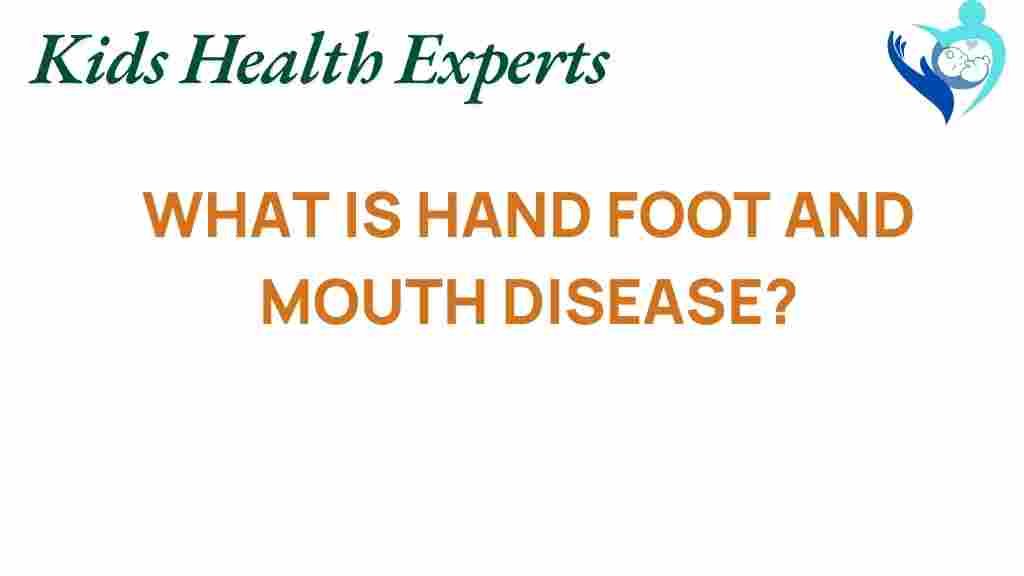Unraveling Hand, Foot, and Mouth Disease: What You Need to Know
Hand, foot, and mouth disease (HFMD) is a common viral infection, particularly affecting children under the age of five. Despite its name, the disease can affect adults as well. Understanding the symptoms, treatment options, and prevention methods is crucial for parents and caregivers. This article aims to provide comprehensive information about hand, foot, and mouth disease, shedding light on its contagious nature, potential outbreaks, and ways to maintain health awareness.
What is Hand, Foot, and Mouth Disease?
Hand, foot, and mouth disease is primarily caused by enteroviruses, most commonly the coxsackievirus. This contagious virus spreads easily in group settings, such as daycare centers and schools. The disease typically presents with mild symptoms but can lead to discomfort and complications in some cases.
Symptoms of Hand, Foot, and Mouth Disease
Recognizing the symptoms of hand, foot, and mouth disease is essential for early intervention. The symptoms usually appear three to seven days after exposure to the virus and may include:
- Fever: A low-grade fever is often the first sign of the infection.
- Oral Sores: Painful sores or ulcers may develop inside the mouth, making eating and drinking difficult.
- Rash: A rash may appear on the palms of the hands and soles of the feet, and sometimes on the buttocks and legs.
- Irritability: Young children may become more irritable than usual due to discomfort.
- Lack of Appetite: The pain from mouth sores can lead to reduced desire to eat.
While the symptoms can be uncomfortable, most cases of hand, foot, and mouth disease resolve within a week to ten days without serious complications.
Treatment for Hand, Foot, and Mouth Disease
Currently, there is no specific antiviral treatment for hand, foot, and mouth disease. However, supportive care can help alleviate symptoms:
- Pain Relief: Over-the-counter pain relievers such as acetaminophen or ibuprofen can help reduce fever and alleviate pain.
- Hydration: Keeping the child well-hydrated is crucial. Offer plenty of fluids, preferably cold drinks, to soothe mouth sores.
- Soft Foods: Encourage soft, bland foods that are easy to swallow, avoiding spicy and acidic foods that may irritate the mouth.
- Topical Treatments: Some topical anesthetics can provide temporary relief from mouth sores.
In most cases, hand, foot, and mouth disease resolves on its own, but if symptoms worsen or complications arise, it is essential to seek medical advice.
Prevention of Hand, Foot, and Mouth Disease
Preventing hand, foot, and mouth disease involves practicing good hygiene and being aware of potential outbreaks. Here are some effective prevention strategies:
- Hand Hygiene: Regular handwashing with soap and water, especially after using the bathroom and before meals, is crucial.
- Avoid Close Contact: Keep children away from infected individuals, especially during outbreaks.
- Disinfect Surfaces: Regularly clean and disinfect frequently-touched surfaces and toys.
- Teach Cough Etiquette: Encourage children to cover their mouths and noses with a tissue or elbow when coughing or sneezing.
- Stay Informed: Be aware of local outbreaks and avoid sending children to school or daycare if they show symptoms.
By implementing these preventive measures, the risk of contracting hand, foot, and mouth disease can be significantly reduced.
Understanding Contagiousness and Outbreaks
Hand, foot, and mouth disease is highly contagious and can spread through:
- Direct Contact: Touching the fluid from the blisters or sores of an infected person.
- Respiratory Droplets: Coughing or sneezing can release the virus into the air.
- Contaminated Surfaces: The virus can survive on surfaces for several hours, making it easy to spread.
Outbreaks are common in settings with many children, such as daycare centers. Parents should be vigilant during peak seasons, typically in the summer and fall months, to prevent the spread of the virus.
Health Awareness and Education
Raising health awareness about hand, foot, and mouth disease is vital for communities. Parents, teachers, and caregivers should educate themselves about the disease, its symptoms, and preventive measures. Here are some steps to promote awareness:
- Workshops and Seminars: Organize educational sessions in schools and community centers to inform parents and caregivers.
- Distribute Informational Material: Provide brochures or flyers detailing symptoms, treatment, and prevention strategies.
- Online Resources: Utilize online platforms to share information and updates about hand, foot, and mouth disease. For more information, visit CDC Hand, Foot, and Mouth Disease.
Troubleshooting Tips for Parents
For parents dealing with hand, foot, and mouth disease, here are some troubleshooting tips:
- Monitor Symptoms: Keep a close eye on your child’s symptoms and note any changes.
- Seek Medical Advice: If your child experiences severe pain, dehydration, or high fever, consult a healthcare professional.
- Encourage Rest: Ensure your child gets plenty of rest to help their body recover.
- Keep Communication Open: Talk to your child about their feelings and discomfort, reassuring them that they will feel better soon.
Conclusion
Hand, foot, and mouth disease is a common yet manageable viral infection, especially among children. Recognizing the symptoms, understanding treatment options, and implementing effective prevention strategies are essential for maintaining health and minimizing the spread of the virus. By fostering awareness and education within communities, we can help reduce the incidence of outbreaks and keep our children safe. Remember, if you suspect your child has hand, foot, and mouth disease, consult a healthcare provider to ensure proper care.
For additional resources and support, check out this helpful guide.
This article is in the category Conditions and created by KidsHealthExperts Team
